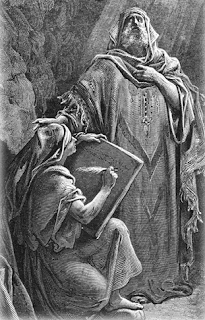
Via DC's: Häxan: pix, info, two clips, three analyses (and there is much more information there):
Häxan integrates fact, fiction, objective reality, hallucination, and different levels of representation—all within a first-person discourse. In the intertitles, Christensen addresses us directly, saying “I.” The mixture of narrative modes in Häxan is astonishing for its freedom and audacity. Early on, Christensen establishes a modern, scientific point of view, stating flatly, “The belief in evil spirits, sorcery, and witchcraft is the result of naïve notions about the mystery of the universe.” After a lecture-with-slideshow-style prologue on ancient and medieval cosmology, diabolism, and sorcery, the first of the film’s narrative recreations unfolds in a sorceress’ underground workshop in 1488. The sequence that follows is, up to a point, objective. But the film soon complicates its logical flow by dissolving from the workshop to a scene in which the sorceress’ client gives a love potion to a monk. The viewer can’t be sure whether the second scene is a flash-forward to an event occurring in the future or, as seems more likely, a representation of the client’s fantasy.
Starting with this ambiguity, the film takes us farther away from a world in which recognized laws of cause and effect hold sway, leading us into a space where the irrational is always ready to intrude in lurid forms. At times, Häxan appears to be a literal depiction of the imaginings of people of medieval Europe—the cinematic equivalent of the medieval woodcuts that illustrate the prologue. Christensen denies us cues indicating the points at which the film jumps from one level of reality to another. As a result, the obscene incursions of the devil (an unforgettable performance by Christensen himself) are consistent with the tonality of the film: the devil belongs to the film’s world even as he disrupts it.
- From The Criterion Collection: Häxan by Chris Fujiwara
Amazon Link: Haxan (Witchcraft Through the Ages) - Criterion Collection
Update: Check out the always intriguing Jahsonic on one of those who spoke most humanely about evil and some nice images.
Update: Check out the always intriguing Jahsonic on one of those who spoke most humanely about evil and some nice images.





